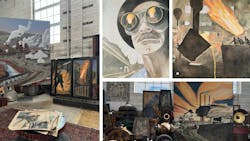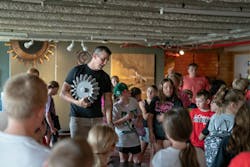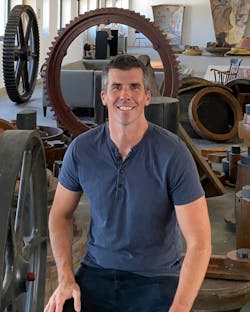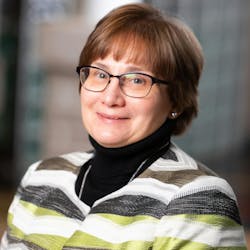Pittsburgh Initiative and METAL Program Inspire Future Mechanical and Design Engineers through Metalworking
Art meets science in a groundbreaking partnership between the Pittsburgh-based Patterns of Meaning Art initiative and the Metallurgical Engineering Trades Apprenticeship & Learning (METAL) program designed to engage K-12 students in the world of steel metal manufacturing. Together they are reshaping how young learners perceive manufacturing not just as heavy industry, but as a vibrant field blending creativity with cutting-edge engineering.
Funded by the U.S. Department of Defense and led by IACMI, the Composites Institute, the METAL program addresses critical workforce gaps in the U.S. metallurgical and manufacturing sectors. Partnering with Patterns of Meaning, a program integrating metal-themed Fine Arts into education, this initiative provides a unique platform for students to explore the technical and artistic sides of metalworking.
“Manufacturing, including steel and metal production, is essential for our future and requires new artisans with creativity and innovation,” said Cory Bonnet, artist and founder of Patterns of Meaning. “Our goal is to transform the cultural view of manufacturing from a declining industry to a creative and vital contributor, showcasing its historic roots and future potential.”
Patterns of Meaning features an unprecedented collection of industrial artifacts, paintings and sculptures made from steel, glass, ceramics and wood. Its K-12 curriculum combines project-based learning with experiential arts exhibits, giving students hands-on exposure to the metalworking industry through creative expression.
The pilot program, launching in Allegheny County and nearby public schools, includes classroom presentations, hands-on projects and field trips to the Patterns of Meeting exhibit hall. Younger students create drawings, paintings and collages, progressing to more advanced projects involving computer aided design (CAD), wax models, sand casting and additive manufacturing—key skills relevant to mechanical and design engineering.
This arts-integrated approach uniquely reaches students who may not traditionally be tracked towards STEM careers, opening new pathways in engineering and manufacturing. Since its 2023 launch, METAL has rapidly expanded its network of university hubs supporting metallurgical training nationwide, including Tennessee Tech, University of Alabama and Michigan Tech, alongside established centers like The Ohio State University and Penn State.
“Patterns of Meaning’s innovative efforts to redefine perceptions of the steel and manufacturing industries aligned perfectly with METAL’s mission to strengthen the future metalworking workforce,” said Lucinda Curry, METAL national workforce manager.
READ MORE: Guided by Curiosity, Grounded in Collaboration
The Patterns of Meaning Workshop and Exhibit Hall can be visited in Pittsburgh's Energy Innovation Center and is currently on display at the Brooklyn Waterfront Artist Coalition through Aug. 24, 2025, as part of the Brooklyn X Pittsburgh: The Industry of Art exhibit.
Through this fusion of art and science, a new generation of mechanical and design engineers is being inspired to envision manufacturing as a field rich with creativity, technical skill and opportunity.
Machine Design had questions about the partnership, so we reached out to Bonnet and Curry for some answers. The following Q&A may have been edited for style and clarity.
Machine Design: How have engineers and technical experts in the METAL program contributed to the Patterns of Meaning curriculum or artwork, and what kinds of engineering concepts are being introduced to students through these projects?
Cory Bonnet: Patterns of Meaning (PoM) is embarking on a brand new partnership with METAL—the first K-12 initiative that PoM has formally participated in. The partnership became official in July 2025. This partnership formed after working with the Steel Founders’ Society of America (SFSA) and being invited to attend the Cast in Steel competition, a metals program in which contestants produce a project and compete using the casting process. I’ve been working on the PoM project since 2021.
We really wanted to focus on honoring industrial heritage and hadn’t brought in the contemporary component yet, which is where METAL comes in. Witnessing the Cast in Steel program and how the students were getting excited about working with engineering departments pulled the curtain back for me to show that steel and metalworking are as much of a present-day subject as they are historic. Steel was extremely important in building our country, but it’s just as important today.
As I was introduced to IACMI and the METAL program, I realized there was a need for a K-12 program in these areas. Many of the programs were focused on older students—high school juniors and seniors and college-level students—with minimal introduction to these ideas early on. The imagery seen every day in foundries and manufacturing is incredible and very exciting for students to see; therefore students get excited about learning. I have found that visual learning is very effective at a young age. Professionals in the metalworking and steel industry have contributed to this program by providing visual learning.
MD: Can you share examples of how cross-disciplinary collaboration between artists, engineers and educators has enhanced student engagement or learning outcomes in metalworking projects?
CB: I’ve seen problems that each of these siloed groups share, but there isn’t much communication between the groups. When you are an artist in a creative space, you’re not tied to predispositions about the right way to do things. This environment allows you to be more open and do more creative problem-solving.
Educators are showing kids, especially creative kids, how math and science relate to creative arts. It has been eye-opening for them because it gets kids who don't necessarily have an inherent interest in math and science to see how they can use it to create better and improve their artwork. That’s also been a personal revelation of mine over the past few years—the more I understand material sciences and engineering, the better and higher-quality my art gets.
READ MORE: On the Hunt for Work at Automate 2025: A Recruiter Offers Perspective
Lucinda Curry: METAL, a workforce development program led by IACMI—the Composites Institute, with funding from the Defense Department’s Industrial Base Analysis and Sustainment Program—has rapidly expanded its U.S. network of university partners since its launch in 2023. METAL aims to strengthen America’s manufacturing workforce, focusing on casting, forging and plate rolling. METAL has created a network of university hubs, including Michigan Technological University, the University of Alabama in Birmingham, The Ohio State University, Tennessee Tech, Pennsylvania State University and the University of Tennessee in Knoxville.
Together, these institutions are driving a nationwide resurgence in metallurgical and manufacturing excellence by expanding access to high-quality, industry-relevant training. METAL combines a curriculum of workshops, online training, and hands-on METAL bootcamps to learn valuable skills in metal properties, heat treatment processes, and advanced manufacturing techniques.
These bootcamps bring professors and students from both art schools and engineering schools to talk and solve problems together. They learn from each other. Engineers are able to look at projects with a more artistic viewpoint and think creatively…and learn that it’s okay to fail, which artists do all the time. This program includes trial and error, which isn’t necessarily taught in the classroom. That is freeing, and gets engineers on the road to innovation.
MD: What feedback have you received from students who never considered engineering or manufacturing careers before participating in the Patterns of Meaning initiative?
CB: Through this program, we have had one classroom visit with fourth graders. The students described the exciting careers they plan to pursue: astronauts, real estate agents, lawyers. The educators have told us that none of the professions in steel and metalworking are even talked about at the younger grade levels, so limited exposure to these opportunities will naturally make them gravitate to different career paths.
Through this partnership, the kids have a whole new world opened up to them and they are responding positively to this, because it’s a career where you’re actually making something and creating a tangible product. These are the types of careers where you get to the end of the day and say, “I created that!”
The visualization of molding and casting is enticing to kids, so showing them what this type of work looks like gets them excited about pursuing it.
READ MORE: Inspiring the Next Generation of Engineers
MD: As the initiative progresses to more complex STEM-based projects such as CAD, sand casting and additive manufacturing, what resources or partnerships have been most valuable in delivering technical content to students?
CB: We are currently building partnerships with industry entities. Things like CAD programs can allow kids to download programs on their iPads and start designing metal and steel projects almost immediately. We are working on programs for kids to create a CAD drawing, then do the additive manufacturing (3D printing) to create a mold, then finally do the casting. These types of programs are valuable in teaching kids how to conduct the project from start to finish.
LC: This initiative requires an ecosystem of many types of people and expertise working together from all sides; this ecosystem will provide what we need for our national security and our commercial sector. And introducing these types of careers to kids at a young age in elementary school, then having them see the programs again in middle and high school, may inspire them to go into engineering school or go straight to work in one of the apprenticeships that are available.
MD: How do you envision today's K-12 students, exposed to both arts and engineering, shaping the future workforce and design challenges in the steel and metals industries?
CB: I think the more minds you have working on a problem, the better. Right now, most schools are structured to teach to interests/strengths. They see where a kid’s strengths are early on and feed them into those tracks. This initiative does a great job of connecting the tracks and introducing them to areas their natural inclinations don’t bend toward. When you have creative minds and creative ideas working with engineering, breakthroughs occur.
The most significant breakthroughs come from these multidisciplinary interactions, because you're solving more than just one problem. If you're only looking at the engineering problem, you may be eliminating the other benefits that this technology or invention could have.
On the opposite side, if it's all creative, you're not seeing how this process that you developed can help to create efficiencies on the manufacturing side. Helping kids see both sides will allow for a better, more well-rounded product.
LC: This initiative gets the right and left parts of the brain working together. When you have people working together from the creative side as well as the engineering side, and collaborating on these problems, then you have a better chance of creating something new. It could be a game-changer. That's how some of the greatest inventions have come about. It’s important to have different perspectives on these projects.
MD: What advice can you offer to engineering professionals or machine designers interested in supporting similar arts-integrated STEM outreach in their regions or companies?
CB: Contact METAL or Cory Bonnet with Patterns of Meaning! Look for opportunities to engage with students at younger levels. Don't wait until they're in high school.
Engineering professionals and machine designers should document everything they are doing with photography and get those images in front of people so they can see the processes they are working on. These images of pouring and melting inspire kids. These professionals can also talk about the history of what they or their company do so that they can measure the progress of their work today.
MD: What unexpected challenges or successes has the METAL Patterns of Meaning partnership encountered as it seeks to bridge the gap between the arts and technical manufacturing education?
CB: One challenge we have faced is getting the word out about this initiative and what the program will accomplish. If you can show the accomplishments, you can show not only kids but also parents to prove that this is an excellent, stable career path for them to enter. Many parents only see a successful future for their child by pursuing a four-year degree, but there are other paths they can take.
These are very honorable and completely viable career paths. A student can go straight into a vocational school or a two-year program as opposed to a four-year program and be presented with so many opportunities. These types of careers also offer on-the-job training and continuing education. There is so much support, and you don’t have to give up further education to enter these fields.
LC: The manufacturers we’re talking to and working with on the apprenticeship and engineering sides value these employees. There is so much growth potential and earning potential in these careers. Many of these employees make as much or more money than some four-year degree programs. And the employees aren’t going into debt to earn these degrees or certifications.
90% of all durable goods have a cast or forged part in them. Every car, every airplane, every piece of equipment—your washing machine, your dryer, your stove. So we cannot go without these manufacturers. It is imperative that we overcome the challenge of disseminating the benefits of this type of work and just how important it is.
Editor’s Note: Machine Design’s WISE (Workers in Science and Engineering) hub compiles our coverage of workplace issues affecting the engineering field, in addition to contributions from equity seeking groups and subject matter experts within various subdisciplines.
About the Author
Sharon Spielman
Technical Editor, Machine Design
As Machine Design’s technical editor, Sharon Spielman produces content for the brand’s focus audience—design and multidisciplinary engineers. Her beat includes 3D printing/CAD; mechanical and motion systems, with an emphasis on pneumatics and linear motion; automation; robotics; and CNC machining.
Spielman has more than three decades of experience as a writer and editor for a range of B2B brands, including those that cover machine design; electrical design and manufacturing; interconnection technology; food and beverage manufacturing; process heating and cooling; finishing; and package converting.
Email: [email protected]
LinkedIn: @sharonspielman
Facebook: Machine Design
YouTube: @MachineDesign-EBM





